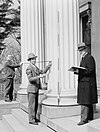File:Interior view, front entrance doors; note; double doors have a box lock, sliding bolt locks into door head and sill as well as modern locks, butt hinges, slightly recessed panels, HABS SC,39-CLEM,1-54.tif

Original file (3,725 × 5,161 pixels, file size: 18.34 MB, MIME type: image/tiff)
Captions
Captions
Summary
[edit]| Photographer |
creator QS:P170,Q6111338 |
|||||||||||||||||||||||||
| Title |
Interior view, front entrance doors; note; double doors have a box lock, sliding bolt locks into door head and sill as well as modern locks, butt hinges, slightly recessed panels, and five-ligh transom - Fort Hill, Clemson University Campus, Clemson, Pickens County, SC |
|||||||||||||||||||||||||
| Description |
Calhoun, John C; Clemson, Thomas G; Price, Virginia Barrett, transmitter; Hiott, William D, historian; Louden, Elizabeth I, delineator; Howell, Martin Jeffrey, delineator; Dochterman, Abby J, delineator; Mui, Helen, delineator; Taylor, A Brooke, delineator; Yuen, Nancy Ka Po, delineator; Gborgiadou, Styliani, delineator; Boucher, Jack E, photographer; Price, Virginia B, transmitter |
|||||||||||||||||||||||||
| Depicted place | South Carolina; Pickens County; Clemson | |||||||||||||||||||||||||
| Date | Documentation compiled after 1933 | |||||||||||||||||||||||||
| Dimensions | 5 x 7 in. | |||||||||||||||||||||||||
| Current location |
Library of Congress Prints and Photographs Division Washington, D.C. 20540 USA http://hdl.loc.gov/loc.pnp/pp.print |
|||||||||||||||||||||||||
| Accession number |
HABS SC,39-CLEM,1-54 |
|||||||||||||||||||||||||
| Credit line |
|
|||||||||||||||||||||||||
| Notes |
The historical significance of Fort Hill rests on the stature of John C. Calhoun, who served almost continually in national politics from 1810 until his death in 1850. In his office at Fort Hill, as Vice President, Calhoun reflected on the constitution and, in the fall of 1828, formulated ideas that were anonymously published as "the South Carolina Exposition and Protest." There, in July of 1831, he also penned his famous "Fort Hill Address" setting forth his doctrine of nullification outlining the concept of states' rights. Calhoun graduated from Yale University and the Tapping Reeve Law School in Litchfield, Connecticut. During his forty years of public service, Calhoun was a member of Congress (1811-17), Secretary of War (1817-25) under James Monroe, Vice President (1828-32) during Andrew Jackson's first term, Senator (1832-43), Secretary of State under John Tyler (1844-45), and again as Senator (1845-50). He is best remembered as a part of the great triumvirate in the U.S. Senate with Henry Clay and Daniel Webster.
|
|||||||||||||||||||||||||
| References |
|
|||||||||||||||||||||||||
| Source | https://www.loc.gov/pictures/item/sc0118.photos.206378p | |||||||||||||||||||||||||
| Permission (Reusing this file) |
|
|||||||||||||||||||||||||
File history
Click on a date/time to view the file as it appeared at that time.
| Date/Time | Thumbnail | Dimensions | User | Comment | |
|---|---|---|---|---|---|
| current | 00:27, 2 August 2014 |  | 3,725 × 5,161 (18.34 MB) | Fæ (talk | contribs) | GWToolset: Creating mediafile for Fæ. HABS 31 July 2014 (3000:3200) |
You cannot overwrite this file.
File usage on Commons
The following page uses this file:
Metadata
This file contains additional information such as Exif metadata which may have been added by the digital camera, scanner, or software program used to create or digitize it. If the file has been modified from its original state, some details such as the timestamp may not fully reflect those of the original file. The timestamp is only as accurate as the clock in the camera, and it may be completely wrong.
| Camera manufacturer | Sinar |
|---|---|
| Camera model | 54H |
| Author | Library of Congress |
| Width | 3,725 px |
| Height | 5,161 px |
| Compression scheme | Uncompressed |
| Pixel composition | Black and white (Black is 0) |
| Orientation | Normal |
| Number of components | 1 |
| Number of rows per strip | 17 |
| Horizontal resolution | 700 dpi |
| Vertical resolution | 700 dpi |
| Data arrangement | chunky format |
| Software used | Stokes Software Inc. IWS - Version 02.04.00.05 |
| File change date and time | 10:25, 22 March 2007 |

